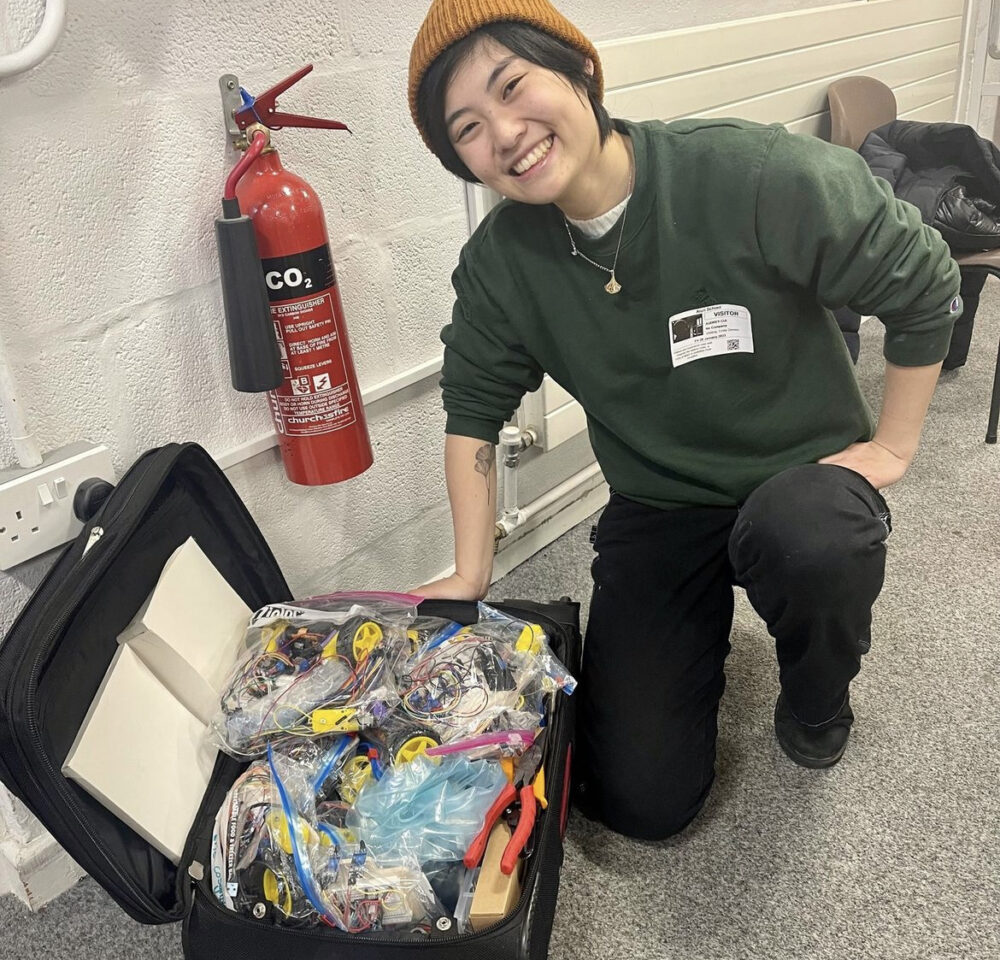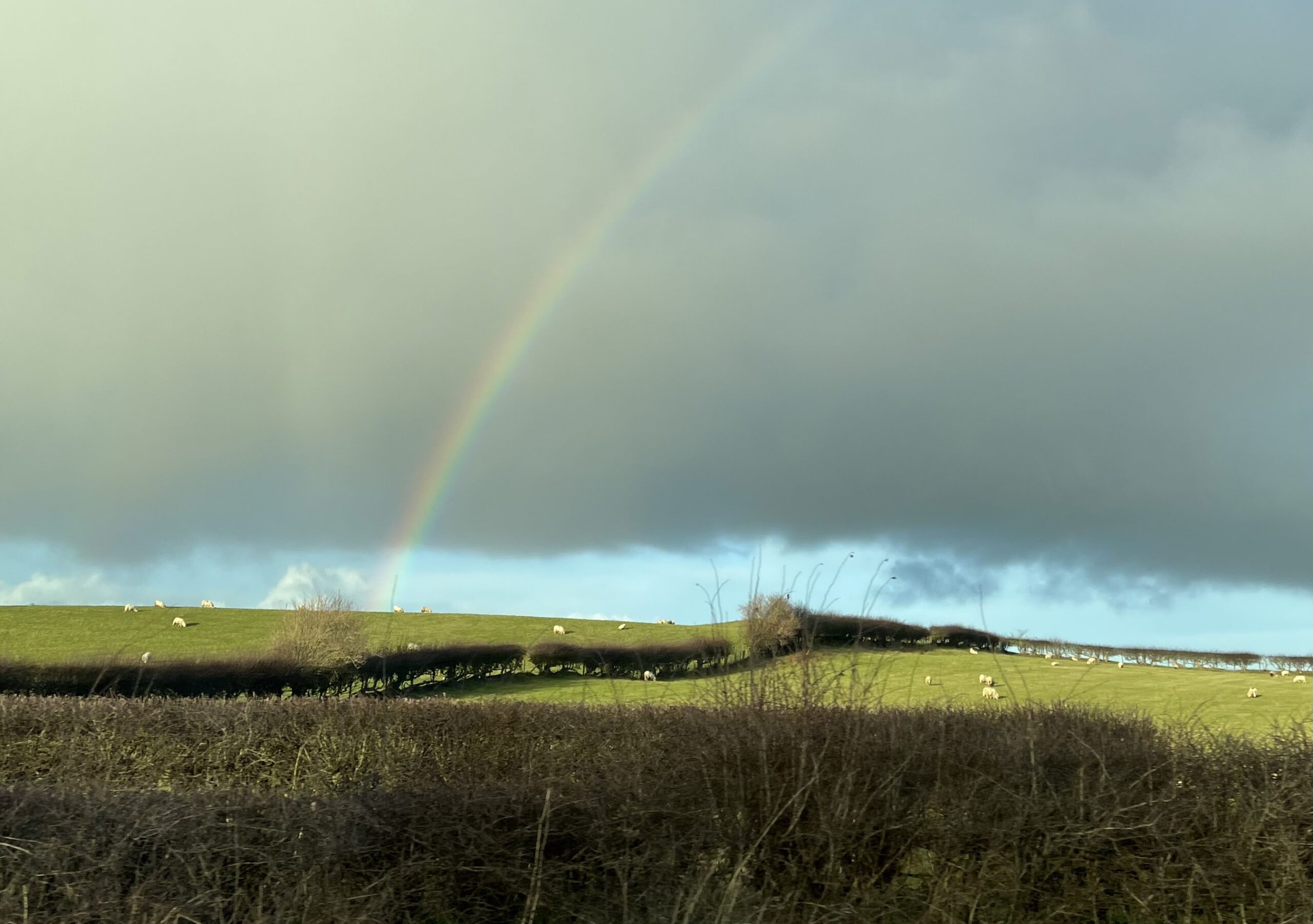
Do Welsh Robots Dream of Electric Sheep? by Audrey C. '24
teaching kids robotics through GTL Wales!
Two summers ago, I visited my friend Shruti ‘24 in their home state of New Jersey. We01 to clarify Shruti did all the driving and my licenseless self was the passenger princess drove up to Paterson Falls, a waterfall in the middle of the industrial city of Paterson.02 fun fact Alexander Hamilton founded Paterson
“Hmm this reminds me of Scotland. Or more like, my imagination of what Scotland might look like.”
So I posted a picture of Paterson Falls flanked by lush, pseudo-Scottish foliage and location tagged it “Scotland, UK.” With the exception of another friend actually from New Jersey, people ate that up. I received many a DM along the lines of, “woah since when were you in Europe?!” I rode the high of my “European” adventure for a few more days, location tagging more pictures of random New Jersey foliage as the British countryside. I eventually came clean with an apology video that could give James Charles a run for his money.
When GTL03 Global Teaching Labs, the wonderful teaching abroad program at MIT applications rolled around, I waxed poetic about my desire to witness a real British landscape (no offense New Jersey). I was matched to a few schools in northern Wales, so that’s where I got shipped to this IAP!
What is Wales?
Prior to GTL, I knew that Wales was a place. A place that included the town with the super long name04 Llanfairpwllgwyngyllgogerychwyrndrobwllllantysiliogogogoch. unfortunately I didn't get to visit, but i did stay at a town called Caernarfon right across from the Menal Strait from Llanfair(...) when I was teaching at nearby towns.<b> and real green grass.05 this is nontrivial to me because i grew up in drought stricken California, where all the green grass was fake and only yellow grass was real grass
Thankfully we had pre-departure meetings organized by Stephen, the MISTI-UK coordinator, to teach us a bit more about Wales’s geopolitics. Wales is one of the four countries that make up the United Kingdom, the other three being England, Scotland, and Northern Ireland. The UK is the fully sovereign state that holds membership in the United Nations, but each country has separate national football teams that compete internationally.
Stephen’s hot take was that if each country put aside their pride to form a UK team, they might’ve stood a fighting chance at the World Cup. The Welsh are indeed proud of their Welshness. It would be blasphemous to call a Welsh entity English, but using the umbrella term British would be generally fine.
A Very Brief Overview of the UK Education System
Across the UK, children attend primary school through Years 1-6 (ages 5-11), and then secondary school from Years 7-11 (ages 11-16). Note that Years in the UK are offset from grades in the US by one; so Year 9 students would be the same age as 8th graders.
Students have some choice for their final two years of mandatory education. One option is taking vocational job training courses, usually offered by an institution called a college. If a student is planning on pursuing post-secondary education (i.e university), they would instead attend what’s called Sixth Form, take 3-4 A Level courses across both years, and take a final exam administered by an outside exam board. Here, “college” and “university” are not interchangeable. I got a few confused looks when I started talking about my “college” experience at MIT.
Preservation of the Welsh language is heavily emphasized in Welsh schools, bolstered by a recently implemented initiative called Cymraeg 2050.06 'one million Welsh speakers by 2050' Even in “English medium” schools where English is the primary language through which instruction is given, students would take mandatory Welsh language classes and often exchange greetings with their teachers in Welsh.
A Herd of Robots
For two out of the three weeks I spent in Wales, I taught a group of thirteen Year 9 students how to make robot cars! I was heavily inspired by the line following robot competition in 2.678,07 Electronics for Mechanical Systems which gave us practice with breadboarding, working with sensors, driving motors, programming an Arduino, and understanding feedback control loops. While 2.678 provided us with robot cars graciously preassembled by the teaching staff, I thought it would be extra cool if my students CAD and assemble the robot car themselves. For that part, I took inspiration from a test robot that everyone built in the first week of 2.007.08 Design & Manufacturing I, aka the robotics competition class
With guidance from my 2.678 & 2.007 profs, I identified ahead of time 3 main constraints for my envisioned project:
- I needed to scale things down. These 13-14 year olds would not have the same math/physics background as an MIT student preparing to take 2.678/2.007.
- I needed to work within the limitations of the secondary school’s resources and budget. A secondary school in the Welsh countryside, albeit a relatively well resourced one, wasn’t going to be anywhere as well equipped as MIT’s plethora of machine shops and makerspaces.
- I would be the only teacher with a technical background instructing the group of 13 kids. I ended up having a substitute teacher in the room during most days, which helped immensely with classroom management, but didn’t help much when ten kids all had different issues with Solidworks at the same time.
When I was planning out my curriculum during winter break, I mostly thought about constraints 1 & 2. I made slides and worksheets, prepared starter CAD files and skeleton code, and packed a suitcase full of electronic parts and hand tools (including 100 mini screwdrivers). For constraint 3, I considered having kids pair up to make my life easier, but my desire for every student to bring their own robot home (and disregard for my future self) ultimately won over.

fun fact my beloved pair of red pliers got confiscated at the Heathrow Airport bc I forgot to take it out of my carryon :(
As things tend to go in school settings, I was gifted many last minute surprises. I had prepared my CAD lessons using Fusion360 with the assumption that the students could download it themselves. The morning of my first day, I learned students couldn’t download anything onto the school computers, but at least the school already had Solidworks licenses. I had never used Solidworks before. Okay, I could just speed learn it before I had to teach it. But the computer lab was in use for two other lessons, then locked afterwards. I finally found someone with a key 20 minutes before my lesson and just barely started fumbling with Solidworks before the kids trickled in.
Okay, I could speed learn Solidworks while I’m teaching it. That was a stupid idea. I had a classroom full of kids complaining about why their “robot parts wouldn’t mate”, but I didn’t know how to mate robots09 The 'mate' operation in Solidworks aligns two separate parts. In my classroom, 'mating robots' became synonymous to CAD. properly either! Solidworks had a lot of the same functionality as Fusion360, but had its own quirks for actually using these functionalities. Then I had a classroom full of kids complaining why “the MIT person” couldn’t mate robots.
The kids were totally valid in being frustrated and honestly handled it well for their age. In retrospect, the sheer panic from this very rocky start made me perceive things as more catastrophic than reality. To put us all out of the misery of mating robot parts, I jumped to a circuits lesson intended for a future date. Not ideal, but ya gotta do what ya gotta do. I stayed after school to learn Solidworks properly and successfully taught everyone how to mate robot parts the next morning.
The rest of the two weeks went a lot smoother (with the exception of the fact that the school deactivated their computers’ USB ports,10 so that students wouldn't plug in their own USB sticks and play games downloaded on them :p so students had to email me to their Arduino code for me to upload from my computer one by one). By the last day, everyone had gotten their robot cars to do “something, literally anything.”11 My original plan was to do a line following competition, but that would've been pretty much impossible if students couldn't upload their own code. Following a line requires a lot of trial and error in calibrating the sensors correctly and finding suitable parameters for the feedback control algorithm. A herd of all 13 robots whizzed around an empty corridor, while a bunch of happy students chasing after them. I watched on the side like a proud soccer mom.

Cultural exchange with Welsh Gen Z’ers
In order to win over my students, I capitalized the fact that I was young and hip enough to understand their latest pop culture obsessions. Apparently, American media has such a large influence on British children that they’ve started saying fries for chips and chips for crisps, much to their parents’ chagrin. Here were the top four frequently asked questions:
- Have you been to Target?
Thanks to the rise of Target content on Tiktok, British children are immensely curious about the American sociocultural phenomena that is Target. I enjoyed this video essay by Tiffany Ferguson, which argues that trips to Target have cemented itself as a form of self-care/self-indulgence in the American zeitgeist, in part because it’s a symbol of the middle/upper-middle class (as opposed to retailers like Walmart that predominately serve lower income communities). I tried to explain this to the kids using less jargon. - What are your thoughts on Meghan Markle?
Both students and teachers alike wanted my take on Meghan Markle. There’s something to be said about her getting unfairly targeted by the press because she’s both American and Black. Beyond that I haven’t given much (if any) thought to Meghan Markle though, and I don’t think the average American is super concerned about British royalty affairs either. I will happily let this occupy my mind though:

- Have you met a famous Youtuber?
Even more than the Year 9’s, the Year 3-6 students that I taught the subsequent week were absolutely obsessed with American Youtubers. “I ran into Jenna Marbles at a Safeway once.” Lukewarm smiles. The underwhelming response was understandable; Jenna Marbles was a bit too old for these kids. “ZHC was a senior at my high school when I was a freshman (but phrased in more British terms).” The class exploded. Every single one of these kids at least knew of ZHC, and many were dedicated fans. I got the impression that to these kids, I was the next best thing to an American Youtuber that they’ve met. They were very well behaved and engaged for the rest of the lesson. - Have you had Prime?
Not Amazon Prime apparently, but rather Prime the energy drink by KSI and Jake Paul. No I have not. I’ve never heard of this Prime drink because I am a boomer. Apparently this stuff is worth going to Asda (British supermarket chain) at the crack of dawn.
Reflections on Teaching
While I’ve always held immense respect for my teachers knowing that it’s a difficult job, experiencing it for myself gave me a deeper understanding for how much it truly takes. It took a physical toll on me to teach from 8am-3pm every weekday and then go home only to prepare the next day’s lessons. Despite having most of my curriculum planned ahead of time, I often found myself rewriting lessons into the wee hours of the morning.
Despite all that, I was playing this teaching game on easy mode, as my class of students was handpicked by the school from the highest achieving Year 9’s. I didn’t have to deal with any severe behavioral issues that would be inevitable in any other classroom. I sometimes forgot that I was teaching these 13-14 year olds skills that I had only learned in the past year or so, as they took on the challenges so well. Even when they got visibly frustrated, they kept trying. Students who figured things out quicker were also happy to give others a hand.
There is also so much to being a teacher outside of teaching.
Many teachers discussed regularly helping students navigate issues outside of the classroom— even if their job titles didn’t say so, they were also counselors, social workers, and unpaid therapists. Not to mention navigating school bureaucracy, taking care of their own families, and fighting for a living wage (teachers across Britain went on strike shortly after I left).
I can see how it’s the little moments that keep teachers going. The excitement on my students’ faces when their robot moved for the first time. Hearing that a student wouldn’t stop telling his parents about how much he loved robotics and CAD and aspired to work on stuff like that as a future job. Being dubbed “Audrey the science lady” by the Year 3-6 students. Target and ZHC.
It was really the constant support given to me by the teacher communities at the schools that helped me find my footing, and soon after, joy in teaching. Every teacher who I had a meaningful interaction with made me feel so welcome here.
Every morning, Kate drove me to school along narrow roads that snaked through the Welsh countryside. We’d exchange news about the dire states of our respective countries.
Then Heather would help unlock the door to my classroom and offer me a cup of coffee, which I’d always accept with great enthusiasm. I’ve miraculously avoided caffeine dependence at MIT so far, so I did not anticipate teaching kids to be the cause of my downfall. I used to hate black coffee as well. Definitely not anymore.
Emily, my host teacher that had put in hours of organizing with the school administration to make the robot project happen, would check up on me between her own classes to make sure I’m doing okay. The British greet each other by asking “are you alright” in the same way Americans might ask “how are you,” and like “how are you” they don’t always expect a real response as to whether you’re actually alright. But Emily always did. She could always tell if a day had been a particularly long one and reassured me that I’m doing just fine as a teacher.
Every time I made a visit to fix up the school’s finicky 3D printer, the school technician Daz would have a nice conversation with me about anything — technology, education, cultural differences between the US/UK. Daz also made me toast a few times after school. I tried marmite (aka vegemite) for the first time. It wasn’t bad, but I wouldn’t voluntarily buy a jar from the store. So after that, he’d make me toast with just butter.
Finally, Kate would drive me back through the Welsh countryside to my homestay.
To wrap things up, enjoy these photos of the REAL Welsh countryside! I had posted a few of them when I took them, only to get inflammatory DMs questioning if I was actually in Wales. Lookin’ atchu, Kellen.

the view outside the primary school that i taught at! sheep pastures were right around the corner (and you could definitely smell it from the school parking lot).

Emily and her boyfriend took me on a walk in the Snowdonia mountains over a weekend!

welsh sheep really said gay rights 🌈
- to clarify Shruti did all the driving and my licenseless self was the passenger princess back to text ↑
- fun fact Alexander Hamilton founded Paterson back to text ↑
- Global Teaching Labs, the wonderful teaching abroad program at MIT back to text ↑
- Llanfairpwllgwyngyllgogerychwyrndrobwllllantysiliogogogoch. unfortunately I didn't get to visit, but i did stay at a town called Caernarfon right across from the Menal Strait from Llanfair(...) when I was teaching at nearby towns. back to text ↑
- this is nontrivial to me because i grew up in drought stricken California, where all the green grass was fake and only yellow grass was real grass back to text ↑
- 'one million Welsh speakers by 2050 back to text ↑
- Electronics for Mechanical Systems back to text ↑
- Design & Manufacturing I, aka the robotics competition class back to text ↑
- The 'mate' operation in Solidworks aligns two separate parts. In my classroom, 'mating robots' became synonymous to CAD. back to text ↑
- so that students wouldn't plug in their own USB sticks and play games downloaded on them :p back to text ↑
- My original plan was to do a line following competition, but that would've been pretty much impossible if students couldn't upload their own code. Following a line requires a lot of trial and error in calibrating the sensors correctly and finding suitable parameters for the feedback control algorithm. back to text ↑